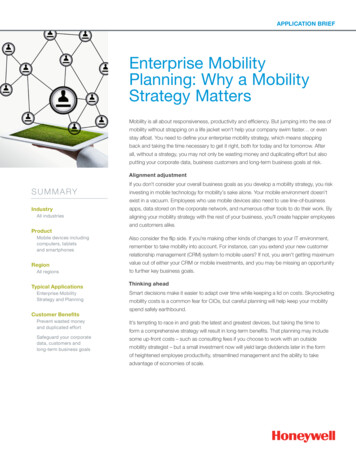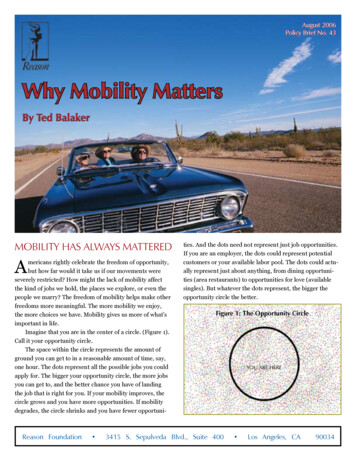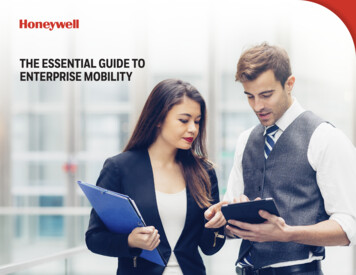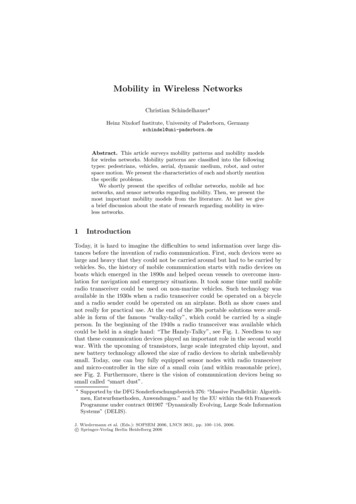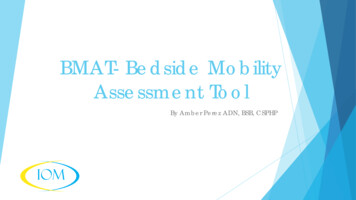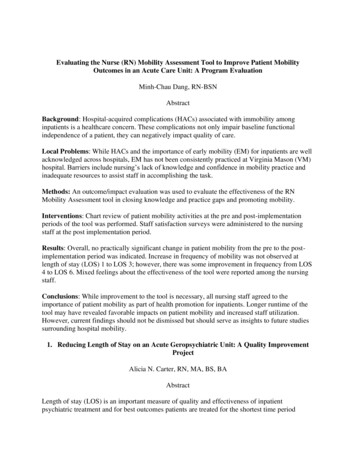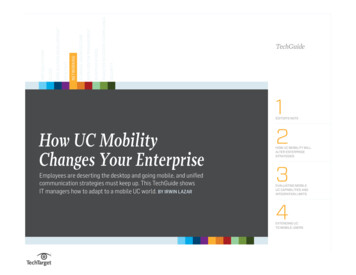
Transcription
SECURITYDISASTER RECOVERY/COMPLIANCEBI/APPLICATIONSDATA CENTER MANAGEMENTSTORAGE ARCHITECTURENETWORKINGHEALTH ITAPPLICATION S NOTEHow UC MobilityChanges Your EnterpriseEmployees are deserting the desktop and going mobile, and unifiedcommunication strategies must keep up. This TechGuide showsIT managers how to adapt to a mobile UC world. BY IRWIN LAZARHOW UC MOBILITY WILLALTER ENTERPRISESTRATEGIES3EVALUATING MOBILEUC CAPABILITIES ANDINTEGRATION LIMITS4EXTENDING UCTO MOBILE USERS
1EDITOR’S NOTEHomeEditor’s NoteHow UC MobilityWill Alter Enterprise StrategiesEvaluating MobileUC Capabilitiesand IntegrationLimitsExtending UC toMobile UsersStrategize, Evaluate, Extend:How to Greet the Mobile UC FutureThe enterprise is going mobile, and ITmanagers must plan now for how they’ll tamethat modern mobilized beast. Even if your employees aren’t bringing their own devices yet,that day is coming, and your unified communications and collaboration tools, strategies andapplications must be prepared to extend to mobile devices that deliver voice, video and data.In other words, it’s out with the old (deskbound worker), and in with the new (mobileemployee); UC tools must grow legs, too.In this TechGuide, UC expert Irwin Lazar escorts you from the initial planning stage to theimplementation stage in three quick chapters.He begins by explaining why now is the time torethink your UC strategy; then he reviews whatadjustments must be made. The goal, whetheryour enterprise is a single- or a multi-vendorUC environment, is delivery of a seamlessmobile user experience without too much ITupheaval.2 H O W U C M O B I L I T Y C H A N G E S YO U R E N T E R P R I S EOnce your new strategy is mapped, it’s timeto implement it. Extending UC to that growingmobile portion of your workforce is a complexundertaking. Everyone can’t have everything,Lazar explains, so policies must be devised upfront to determine who gets what.Creating new mobile UC policies is a crucialtask for IT. But once implemented, mobile UCrequires that you monitor usage and adjust tochanges in worker roles and technology, bothof which will evolve even faster than you canimagine.The demands of mobile UC are a lot for ITmanagers to get their heads around, but it’scritical that they do. This TechGuide providesthe essential information you need to makeforward-thinking choices for your mobile UCstrategy. nBrenda L. HorriganAssociate Managing Editor, Networking Group
2STRATEGIZEHomeEditor’s NoteHow UC MobilityWill Alter Enterprise StrategiesEvaluating MobileUC Capabilitiesand IntegrationLimitsExtending UC toMobile UsersHow UC Mobility Will Alter Enterprise StrategiesThe statistics on enterprise adoption ofmobile devices are staggering. Already, in morethan half of all companies, 12% or more of employees are using their mobile devices as theirprimary computing platforms. Seventy-threepercent of companies expect the number ofemployees who primarily use mobile devices toincrease over the next year, while almost 10%are already replacing desktop or laptop computers with tablets.Given these trends, IT managers must proactively plan to integrate mobile devices intotheir unified communications (UC) strategies.Already, this is starting to happen: Nine percent of companies now extend instant messaging (IM) to their mobile users, while another30% are integrating voice in some manner—typically by implementing simultaneous ringor extension forwarding to mobile devices. Butintegrating UC and mobile devices is more thansimple call forwarding. Modern mobile clients3 H O W U C M O B I L I T Y C H A N G E S YO U R E N T E R P R I S Efrom UC vendors like Avaya, Cisco, Microsoft,Mitel, ShoreTel and Siemens increasingly aimto provide an identical user experience fordesktop and mobile users, by extending applications (such as IM, voice, audio/Web conferencing and even video) to mobile phones andtablets.For those seeking to extend UC to their mobile users, the critical first step is to figure outa client strategy. This is pretty straightforward in a single-vendor environment, whereall UC applications are already integrated; theobvious approach is to deploy the UC vendor’s own mobile client across the enterprise.But few companies have just one UC vendor.Many use IM applications from vendors suchas IBM and Microsoft, voice from any one ofa number of IP-PBX (or even TDM) vendors,various video conferencing platforms, and amix of Web conferencing products and services. Much of the vendor effort to create an
2STRATEGIZEHomeinteroperable, integrated end-user UC experience has focused on the desktop. Today, a Microsoft Lync customer, for example, using theplatform for IM and Web conferencing, can integrate call control from Avaya or Cisco into theLync desktop client, creating a single dashboardapplication for messaging, video and voice.Editor’s NoteHow UC MobilityWill Alter Enterprise StrategiesEvaluating MobileUC Capabilitiesand IntegrationLimitsExtending UC toMobile UsersTHE COMPLEXITIES OF UCIn the mobile world, it’s not so simple. UC vendors typically don’t have a mobile applicationprogram interface strategy to allow third-partyapplications to plug into their mobile clients.Instead, companies in a heterogeneous UC environment must either deploy multiple mobileclients (i.e., one for IM, one for video and onefor voice), or look to a third-party integratedmobility provider (such as AudioCodes and4 H O W U C M O B I L I T Y C H A N G E S YO U R E N T E R P R I S EShoreTel for traditional deployments, or Esnafor cloud/on-premises integration). The firstapproach creates user confusion and complexity, while the latter can provide a disjointedset of capabilities between desktop and mobiledevices.As a result, once UC architects decide to deliver mobile capability, they often begin to rethink their overall UC strategy, moving from amix of vendors to a single-vendor approach, primarily so they can deliver an integrated mobileclient that aligns with their desktop strategy.UC planners should carefully evaluate themobility capabilities of their vendors—including their partnerships and third-party vendorrelationships—with the goal of providing aseamless, single-client option to their users,even if it means rethinking the overall UC architecture. n
3EVALUATEHomeEditor’s NoteHow UC MobilityWill Alter Enterprise StrategiesEvaluating MobileUC Capabilitiesand IntegrationLimitsExtending UC toMobile UsersEvaluating Mobile UC Capabilitiesand Understanding Integration LimitsThe computing environment within theenterprise is changing: 92% of companies support bring your own device, allowing employees to use personal smartphones to connect tocorporate applications. By the end of 2014, onaverage, one-fifth of employees will use a tablet as their primary computing device. Withthe rapid addition of mobile devices comes achange in patterns for their use: Employees demand more than just access to email, calendarand contacts—they want to have all the sameapplications on their mobile device that theyenjoy on their desktop, including UC. As a result, IT architects are scrambling to incorporatetablets and smartphones into their UC plans.According to the Nemertes Research 2013-14Enterprise Technology Benchmark, 24% of IPtelephony clients will be mobile endpoints bythe end of this year. For those responsible fordelivering UC to these devices, this requirespicking a solution that not only best fits the5 H O W U C M O B I L I T Y C H A N G E S YO U R E N T E R P R I S Euser’s need but also integrates well with existing (and planned) infrastructure.Delivering an integrated UC experience onmobile devices is more difficult than on a desktop or laptop computer. On the desktop, mostUC vendors deliver plug-ins for other applications, or support application program interfaces that enable third party plug-ins for theirown desktop apps. Among these are connectorsfor Microsoft Outlook; Avaya and Cisco telephony integration with Microsoft Lync or IBMSametime; Google Apps federation with UCplatforms; and Vidyo’s video-conferencing integration with Lync.THREE APPROACHES TO MOBILE UCIn the mobile world it’s a different story, wheremobile app vendors rarely allow third-partyplug-ins. So enterprise planners are faced witha choice: They can provision a multitude of
3EVALUATEHomeEditor’s NoteHow UC MobilityWill Alter Enterprise StrategiesEvaluating MobileUC Capabilitiesand IntegrationLimitsExtending UC toMobile Usersdifferent applications for each UC feature (telephony, video, instant messaging, or IM, and soon), provision a single client that can interfacewith multiple back-end platforms, or consolidate backend platforms through a single vendor.The first choice is easy for IT, but difficultfor end users. A UC mobility program will notsucceed if it requires employees to click on adifferent app for each service, with no integration between them. If that’s the path chosen,workers will simply gravitate to consumer services like Skype that already integrate voice,messaging and video.nThe second approach, which vendors likeAudioCodes, ShoreTel and Varaha offer, ismore user-friendly, but the back-end optionsthat they support are often limited. This meansan integrated client may not support all existing UC platforms.nThe third choice offers the most potential for a seamless user experience, but alsoholds the biggest potential for IT upheaval.Many companies run a variety of UC platformsn6 H O W U C M O B I L I T Y C H A N G E S YO U R E N T E R P R I S Etoday—for example, Cisco or Avaya for voice,Polycom for video and Microsoft Lync for IM/presence—coupled with hosted Web-conferencing technology from a service provider. Inthis scenario, IT leaders look at their optionsfor supporting mobile users and determinethat the best approach is convergence around asingle platform that eliminates the need to runmultiple applications or delve into the messyworld of system integration. With the consolidation approach, companies can often reduceoperating costs, complexity and licensing requirements, though putting all the IT eggs inone basket carries with it its own set of risks,with the enterprise dependent on the chosenvendor’s ability to deliver against short- andlong-term needs.Those responsible for UC should pay careful attention to the needs of their increasinglymobile workforce. They need to meet with current vendors to assess the latter’s ability to notonly provide mobile apps, but also integrateservices for mobile access. They should alsoevaluate the feasibility of continuing to operatea mixed-vendor architecture, given mobile integration limitations. n
4EXTENDHomeEditor’s NoteHow UC MobilityWill Alter Enterprise StrategiesEvaluating MobileUC Capabilitiesand IntegrationLimitsExtending UC toMobile UsersExtending UC to Mobile UsersExtending unified communications(UC) to mobile users is among the highest priorities for IT architects. As a result of bringyour own device policies, coupled with growing demand for anytime-anywhere access tocorporate applications, more than half of companies are extending, or planning to extend UCapplications including enterprise telephony, instant messaging, Web conferencing and videoconferencing to mobile devices.But extending UC to mobile devices isn’tfree: Companies must plan to spend onwireless LAN upgrades, data plans, licensing, as well as mobile device management(MDM) and mobile application management(MAM) platforms for provisioning, maintenance, and security. For many companies an“everyone gets mobile UC” approach simplyisn’t feasible; rather, IT and business leadersmust establish policies to determine who getswhat, and who doesn’t.7 H O W U C M O B I L I T Y C H A N G E S YO U R E N T E R P R I S ECHOOSE THE RIGHT MOBILE USER FOR UCThe typical approach is for IT leaders to workwith business managers to define worker profiles. A field worker who spends little time inthe office, but must collaborate with colleaguesfrom wherever he or she may be, is an idealcandidate for company-supported mobile UC,whereas a contact center agent who works afixed shift within a call center and who isn’ton-call or who doesn’t require reachabilitywhen outside the office is not. Creating profilescan present a challenge as worker roles shift.Managing role assignments requires administrative overhead. For some, the cost of developing and managing profiles in a rapidly changingorganization isn’t worth the cost. Therefore werecommend minimizing the number of different roles: Twenty-five roles with twenty-fiveseparate policies aren’t manageable; two orthree are.After creating profiles comes the job of
4EXTENDHomeEditor’s NoteHow UC MobilityWill Alter Enterprise StrategiesEvaluating MobileUC Capabilitiesand IntegrationLimitsExtending UC toMobile Usersdetermining which applications each workerprofile can access, and who pays. A travelingworker may require access to every corporate UC application with voice and data plansfully reimbursed by the company, whereas abranch manager may need access to email andsingle-number reach, but might not need mobile Web conferencing, social tools or video.Those allocating costs to business units needto determine reimbursement plans, and howto deal with exceptions, such as the workerwho regularly downloads movies to his or hercorporate iPhone and runs up large data capcharges. Those that wish to extend video tomobile devices must understand the impact ondata plans of high definition video conferencing over cellular networks.CONTROLLING MOBILE UC USAGEHere’s where MDM and MAM come into play:By adopting a corporate MDM and MAM, ITadministrators can control what services aredelivered, how much data is used and what, ifany, restrictions are placed on using applica-8 H O W U C M O B I L I T Y C H A N G E S YO U R E N T E R P R I S Etions over cellular data networks. A company,for example, may wish to limit video conferencing usage to only when a user is connectedto a wireless LAN to avoid running up largedata usage charges from the cellular carrier.MAMs can limit the ability of users to installunauthorized applications on their devices.Longer term, IT leaders should be aware ofthe continued convergence of UC applicationsinto a common user application. Web conferencing, chat, voice and video are increasinglyintegrated into a single application, makingit more difficult to control access. IT leadersshould work with their vendors to understandwhat, if any, controls they can provision (e.g.,turning off video) even in a bundled mobileapplication.Finally, crafting mobile UC policies requirescontinual monitoring of usage and evolving requirements. As roles change, as requirementschange, and as technologies change, IT leaderswill want to continually revisit their policiesto ensure that they balance the need for security, performance and cost management withbusiness needs for agility and innovation. n
ABOUTTHEAUTHORSHomeIRWIN LAZAR is vice president and service directorat Nemertes Research, where he develops andmanages research projects, develops cost models,conducts strategic seminars and advises clients.Lazar is responsible for benchmarking the adoptionand use of emerging technologies in the enterprise,including unified communications, collaborationand advanced network services, and more.Editor’s NoteHow UC Mobility Changes Your Enterprise is aNetworking Media Group e-publication.Kate Gerwig Editorial DirectorRivka Gewirtz Little Executive EditorKara Gattine Senior Managing EditorHow UC MobilityWill Alter Enterprise StrategiesChuck Moozakis Site EditorTessa Parmenter Site EditorBrenda L. Horrigan Associate Managing EditorEvaluating MobileUC Capabilitiesand IntegrationLimitsLinda Koury Director of Online DesignNeva Maniscalco Graphic DesignerDoug Olender Vice President/Group Publisherdolender@techtarget.comExtending UC toMobile UsersTechTarget275 Grove Street, Newton, MA 02466www.techtarget.com 2014 TechTarget Inc. No part of this publication may be transmitted or reproduced in any form or by any means without written permission from thepublisher. TechTarget reprints are available through The YGS Group.About TechTarget: TechTarget publishes media for information technologyprofessionals. More than 100 focused websites enable quick access to a deepstore of news, advice and analysis about the technologies, products and processes crucial to your job. Our live and virtual events give you direct access toindependent expert commentary and advice. At IT Knowledge Exchange, oursocial community, you can get advice and share solutions with peers and experts.9 H O W U C M O B I L I T Y C H A N G E S YO U R E N T E R P R I S E
how uc mobility will alter enterprise strategies 3 evaluating mobile uc capabilities and integration limits 4 extending uc to mobile users virtualization cloud application development health it networking storage architecture data center management bi/applications disaster recovery/compliance security how uc mobility changes your enterprise


